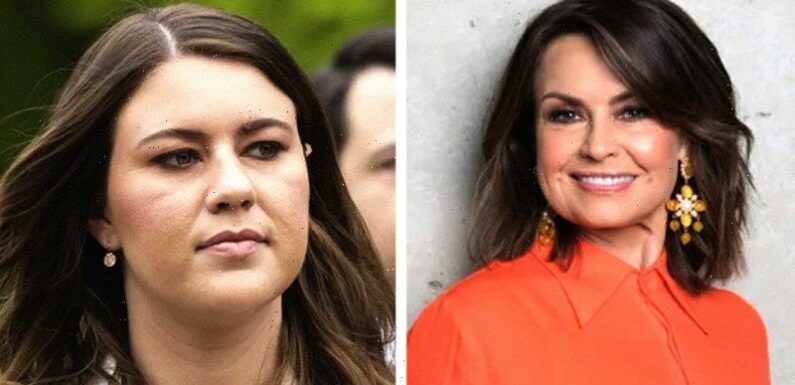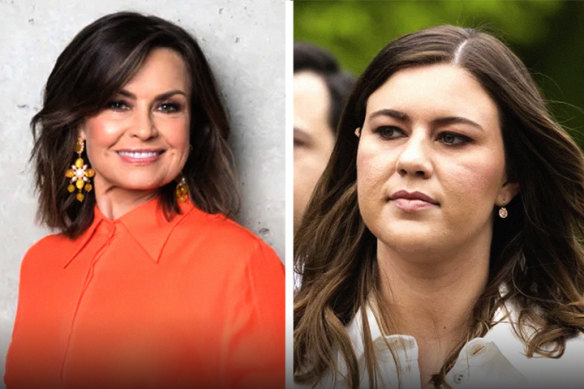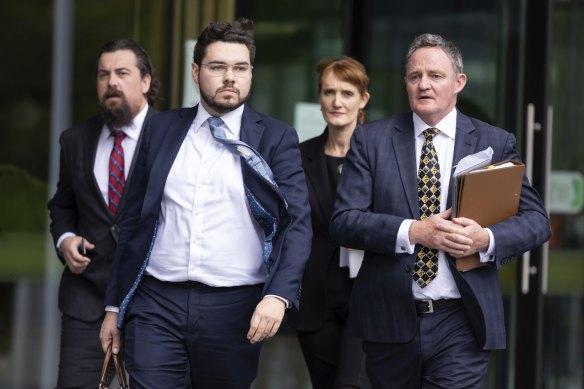
Key points
- Bruce Lehrmann has filed defamation proceedings against Ten and News Corp over interviews with Brittany Higgins in 2021.
- The lawsuits also name journalists Lisa Wilkinson and Samantha Maiden.
- Lehrmann was not named in either interview but his lawyers say that he was identified by a range of means.
- He needs a one-year limitation period extended to bring the lawsuit.
Brittany Higgins is prepared to give evidence as part of Lisa Wilkinson’s truth defence in the defamation case brought against the veteran journalist by Bruce Lehrmann, who is suing over an interview that he says accuses him of raping Higgins in Parliament House.
Lehrmann, a former federal Liberal staffer, filed Federal Court defamation proceedings against Network Ten and Wilkinson last month over Wilkinson’s interview with his former colleague Higgins on The Project, broadcast on February 15, 2021, and related publications on the 10Play website and YouTube.
Network Ten journalist Lisa Wilkinson is being sued for defamation over an interview with Brittany Higgins.Credit:Janie Barrett, Alex Ellinghausen
Lehrmann alleges the publications convey four defamatory meanings, including that he “raped Brittany Higgins in [then-]defence minister Linda Reynolds’ office in 2019”.
Wilkinson, who has briefed her own lawyers to represent her while Ten has a separate team, filed her written defence to the lawsuit in the Federal Court in Sydney on Wednesday. It is the first defence filed in the proceedings.
Wilkinson opposes time extension
The television star opposes Lehrmann’s application to the court to extend a one-year limitation period to allow him to sue over the broadcast, which is now two years old, but she has also indicated she will seek to rely on a range of defences if required, including a truth defence to the rape claim.
Sources close to Higgins, who declined to speak publicly while the matter is before the court, confirmed on Thursday that she would give evidence in the defamation trial, should it proceed and she is subpoenaed to appear. It is an offence to disobey a subpoena.
Despite rumours of a falling out, Higgins and Wilkinson remain close.
Wilkinson was approached for comment via her lawyer.
The truth defence
Wilkinson’s lawyers, headed by Sydney defamation barrister Sue Chrysanthou, SC, say in her written defence that she does not admit Lehrmann was identified by any viewer of the broadcast, which did not name him.
However, Wilkinson “admits that if Lehrmann was so reasonably identified by any viewer on 15 February 2021 … [the broadcast] carried an imputation that Lehrmann raped Brittany Higgins” in Parliament House in 2019.
Wilkinson seeks to rely on a defence of qualified privilege, a defence related to publications of public interest where a publisher has acted reasonably. But, crucially, she also seeks to rely on a defence of truth.
The written defence sets out a series of allegations about Lehrmann’s conduct on the night of March 22, 2019, and says: “Lehrmann’s conduct … amounted to rape of Higgins in Parliament House in 2019”.
Truth is a high bar
Should it proceed to trial and the truth defence is considered, Wilkinson’s lawyers will need to prove on the balance of probabilities – meaning it is more likely than not – that Lehrmann raped Higgins in Parliament House in 2019.
While this is less onerous than the criminal standard of proof beyond reasonable doubt, the so-called Briginshaw principle applies in civil cases involving serious allegations and requires courts to proceed cautiously in making grave findings.
Unlike in a criminal trial, Lehrmann does not have a right to silence and a judge may make adverse inferences if he fails to give evidence. He is expected to appear in the witness box and be cross-examined by barristers for Wilkinson and Ten.
University of Sydney Professor David Rolph, an expert in defamation law, said: “In our system of law, the defendant bears the onus of proof. The defendant will have to prove that the allegations are substantially true on the balance of probabilities, but taking into account the seriousness of the allegations.
“The defendant will have to prove truth by reference to admissible evidence.”
The plaintiff does not have to prove that an allegation is false.
It is not uncommon for media companies to seek to prove serious crimes in defamation cases. The Sydney Morning Herald and The Age are seeking to defend a defamation suit brought by war veteran Ben Roberts-Smith by arguing he committed war crimes in Afghanistan. Roberts-Smith vehemently denies the allegations. Federal Court Justice Anthony Besanko reserved his decision last year.
In 2014, Sydney newspaper The Daily Telegraph indicated it would seek to rely on a truth defence in a defamation case brought against it by Gordon Wood, who was acquitted in 2012 of murdering his girlfriend Caroline Byrne. He accused the Telegraph of branding him a murderer. The defamation case ultimately settled out of court.
And in 2009, The Australian successfully defended a defamation suit brought against it by Serbian paramilitary leader Dragan Vasiljkovic. The NSW Supreme Court found the newspaper had proven Vasiljkovic was a death squad commander who had condoned the rape of women and girls.
University of Melbourne Law School Associate Professor Jason Bosland, director of the Media and Communications Law Research Network, said the truth defence “requires that the substance of the allegation be established”.
‘That standard will be more difficult to satisfy where the allegation is serious.’
“In this instance, Lisa Wilkinson is trying to do that by establishing Lehrmann did in fact rape Brittany Higgins,” Bosland said.
“The strength of the evidence that you require to establish a particular fact on the balance of probabilities will depend on the nature of the allegation.
“That standard will be more difficult to satisfy where the allegation is serious. For example, an allegation of criminal conduct.”
Who is paying Wilkinson’s costs?
Wilkinson, who has been the subject of significant media attention over the lawsuit, has opted to brief her own legal team, headed by Chrysanthou, while Ten has briefed the Melbourne-based Matt Collins, KC.
It raises the prospect the Federal Court may make different findings against each of Wilkinson and Ten about their legal responsibility for the broadcasts. Wilkinson left The Project last year but remains a Ten employee.
Her lawyers say in her written defence that Wilkinson is “an employee for the purposes of the Employers’ Liability Act”, a NSW law that sets out the circumstances in which an employer is liable for their employees’ conduct, including for torts such as defamation.
That law says an employer is “liable to indemnify the employee in respect of liability incurred by the employee” in certain circumstances, and the usual position would be that Ten would be liable for Wilkinson’s costs and any damages payout.
Bruce Lehrmann (second left) departs the ACT Supreme Court in Canberra on October 25, 2022.Credit:Alex Ellinghausen
News Corp defending separate case
Lehrmann has filed a separate defamation claim against News Life Media, the News Corp company behind news.com.au, over two articles by political editor Samantha Maiden, also published on February 15, 2021. News and Maiden are expected to file a defence within days.
Lehrmann was named in the media on August 7, 2021, after he was charged with one charge of sexual intercourse without consent.
He pleaded not guilty to the charge. His trial was aborted in October last year due to juror misconduct and the charge was later dropped altogether amid concerns about Higgins’ mental health. Lehrmann has always maintained his innocence.
The parties in both defamation proceedings are set to appear in court for a preliminary hearing on March 16.
The Morning Edition newsletter is our guide to the day’s most important and interesting stories, analysis and insights. Sign up here.
Most Viewed in National
From our partners
Source: Read Full Article

